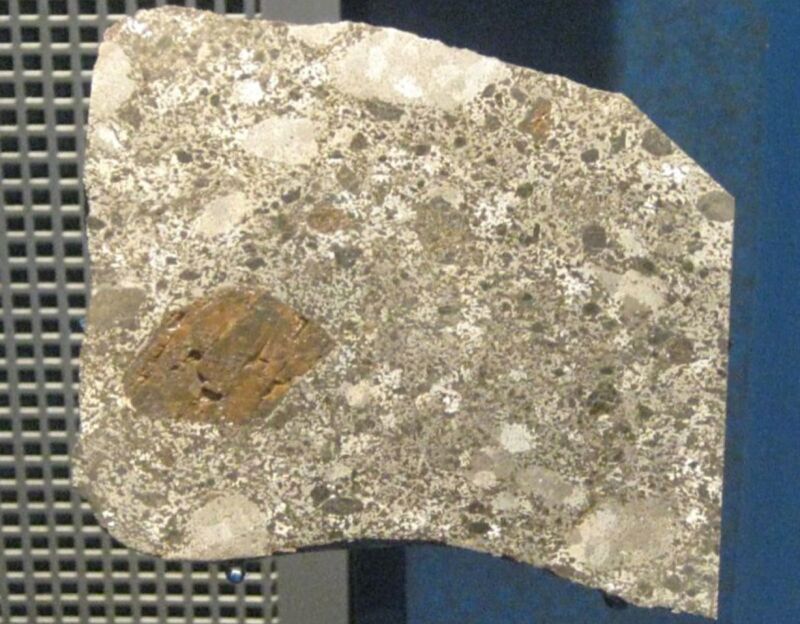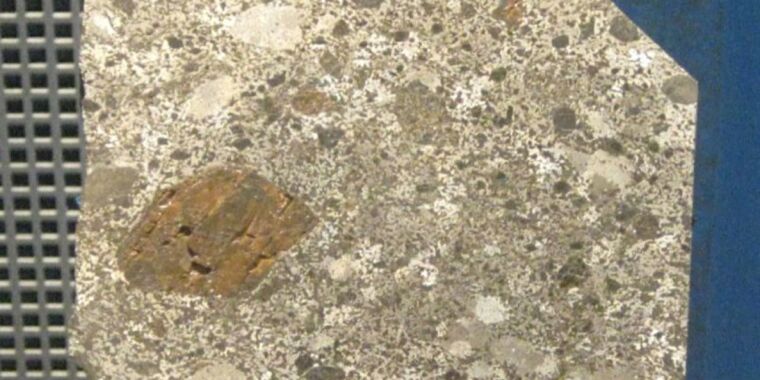A giant meteorite has been lost in the desert since 1916—here’s how we might find it
“This story has everything…” —
A tale of “sand dunes, a guy named Gaston, secret aeromagnetic surveys, and camel drivers.”

Enlarge / Chinguetti slice at the National Museum of Natural History. A larger meteorite reported in 1916 hasn’t been spotted since.
In 1916, a French consular official reported finding a giant “iron hill” deep in the Sahara desert, roughly 45 kilometers (28 miles) from Chinguetti, Mauritania—purportedly a meteorite (technically a mesosiderite) some 40 meters (130 feet) tall and 100 meters (330 feet) long. He brought back a small fragment, but the meteorite hasn’t been found again since, despite the efforts of multiple expeditions, calling its very existence into question.
Three British researchers have conducted their own analysis and proposed a means of determining once and for all whether the Chinguetti meteorite really exists, detailing their findings in a new preprint posted to the physics arXiv. They contend that they have narrowed down the likely locations where the meteorite might be buried under high sand dunes and are currently awaiting access to data from a magnetometer survey of the region in hopes of either finding the mysterious missing meteorite or confirming that it likely never existed.
Captain Gaston Ripert was in charge of the Chinguetti camel corps. One day he overheard a conversation among the chameliers (camel drivers) about an unusual iron hill in the desert. He convinced a local chief to guide him there one night, taking Ripert on a 10-hour camel ride along a “disorienting” route, making a few detours along the way. He may even have been literally blindfolded, depending on how one interprets the French phrase en aveugle, which can mean either “blind” (i.e. without a compass) or “blindfolded.” The 4-kilogram fragment Ripert collected was later analyzed by noted geologist Alfred Lacroix, who considered it a significant discovery. But when others failed to locate the larger Chinguetti meteorite, people started to doubt Ripert’s story.
“I know that the general opinion is that the stone does not exist; that to some, I am purely and simply an imposter who picked up a metallic specimen,” Ripert wrote to French naturalist Theodore Monod in 1934. “That to others, I am a simpleton who mistook a sandstone outcrop for an enormous meteorite. I shall do nothing to disabuse them, I know only what I saw.”
Encouraged by a separate report of local blacksmiths claiming to recover iron from a giant block somewhere east or southeast of Chinguetti, Monod intermittently searched for the meteorite several times over the ensuing decades, to no avail. A pilot named Jacques Gallouédec thought he spotted a dark silhouette in the Saharan dunes in the 1980s. But neither Monod nor a second expedition in the late 1990s—documented by the UK’s Channel 4—could find anything. Monod concluded in 1989 that Ripert had likely mistakenly identified a sedimentary rock “with no trace of metal” as a meteorite.
Still, as Rutgers University physicist Matt Buckley noted on Bluesky, “This story has everything: giant unexplained meteorites, sand dunes, a guy named Gaston, ductile nickel needles, secret aeromagnetic surveys, and camel drivers.” So naturally, it intrigued Stephen Warren of Imperial College London, Oxford University’s Ekaterini Protopapa, and Robert Warren, who began their own search for the mysterious missing meteorite in 2020.
A giant meteorite has been lost in the desert since 1916—here’s how we might find it Read More »
